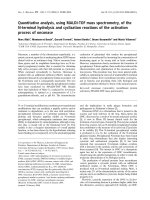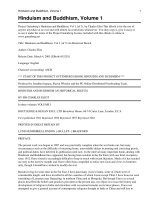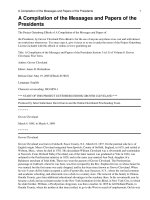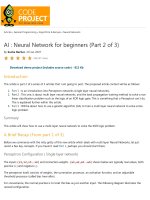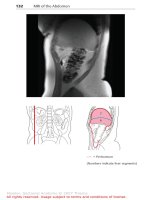Organocatalytic reactions of 3 hydroxy 2 pyrone and n arylsulfonyl 3 hydroxy 2 pyridone 1
Bạn đang xem bản rút gọn của tài liệu. Xem và tải ngay bản đầy đủ của tài liệu tại đây (177.58 KB, 10 trang )
Chapter 1
1
Chapter 1
Introduction
Chapter 1
2
1.1 Br
Ønsted-Base Catalyzed Diels-Alder Reactions
The Diels-Alder (DA) reaction is unarguably one of the most powerful bond
forming reactions in organic chemistry as it creates as many as 4 contiguous chiral
centres in one single reaction. Since its discovery, it has brought about much
advancement in contemporary synthetic organic chemistry.
1
The methods whereby DA
reactions are traditionally and conventionally carried out included reflux and the use of
Lewis acids as catalysts.
2
On the other hand, the use of BrØnsted bases as catalysts is a
relatively rarer approach.
3
Rickborn and Koerner were the first to observe that anthrones can behave as
dienes and able to take part in DA reactions with several dienophiles.
4
However, it was
Kagan and Riant who reported the first enantioselective reaction of anthrones catalyzed
by Cinchona alkaloids (Scheme 1.1).
5
Excellent yields were obtained, nevertheless, there
is still much room for improvement in the enantioselectivity.
O
N
O
O
Me
+
10 mol% cat.
CHCl
3
,-50
o
C
HO
N
O
Me
O
97% yield, 61% ee
2a
quinidine as catalyst
N
H
N
OMe OH
Scheme 1.1 Diels-Alder reaction of anthrone and N-methyl maleimide catalyzed by
quinidine.
Yamamoto et al. attempted to improve this anthrone DA reaction using
pyrrolidine derivatives as catalysts. Chiral maleimides were used and great results were
Chapter 1
3
obtained (Scheme 1.2).
6
The diastereoselectivity was 80%. Pyrrolidine derivatives with a
pyridyl group proved to be the best catalysts giving an enantiomeric excess of 87%
(Scheme 1.3).
7
A transition state model between the catalyst and the substrates held
together by ionic interactions and hydrogen bondings was also proposed by the authors.
O
N
O
O
+
10mol% cat.
CHCl
3
,rt
major isomer
NH
OH
OH
R
1
Me
H
OH
N
O
O
R
1
H
Me
Scheme 1.2 DA reaction of anthrone and a chiral maleimide catalyzed by C2-symmetric
pyrrolidine diol.
Scheme 1.3 DA reaction of anthrone and N-aryl maleimide catalyzed by N-pyridyl
methyl pyrrolidine diol.
This anthrone DA reaction was further improved by our group when a Br
Ønsted–
basic bicyclic guanidine was used as the catalyst (Scheme 1.4).
8
Good yields of the
cycloadducts were obtained and excellent enantioselectivities were achieved. The
regioselectivity was also excellent. The absolute configuration of the compound was
determined using X-ray analysis.
Chapter 1
4
Scheme 1.4 DA reaction of anthrone and N-aryl maleimide catalyzed by C2-symmetric
bicyclic guanidine.
Scheme 1.5 Michael reaction of dithranol and N-benzyl maleimide catalyzed by C2-
symmetric bicyclic guanidine.
In addition, it was also found that when the structure of anthrone was slightly
altered to include hydroxy groups, i.e. dithranol, the reaction between dithranol and
maleimides will give a Michael product (Scheme 1.5). No Diels-Alder product was
obtained.
Okamura et al. was the first group to report that Br
Ønsted bases such as
triethylamine (NEt
3
) can catalyze the Diels-Alder reactions of 3-hydroxy-2-pyrone and
electron deficient dienophiles giving cycloadducts in good yields.
9
The use of the base
varied from a catalytic amount of 0.1 equivalent to 1.0 equivalent and in all cases good
yields were obtained (Scheme 1.6).
Chapter 1
5
Scheme 1.6 DA reaction of 3-hydroxy-2-pyrone 1.
The enantioselective version was explored by the same group using Cinchona alkaloids
(Figure 1.1).
10
Enantiomeric excess as high as 77% was obtained and the selectivity was
good.
N
N
HO
R
R = H, cinchonidine
R = OMe, quinine
R
1
=R
2
= H, cinchonine
R
1
=CH
3
CO, R
2
=H
R
1
=PhCO,R
2
=H
R
1
=H,R
2
= OMe, quinidine
H
N
HN
OR
1
R
2
Figure 1.1 Cinchona alkaloids used.
The best results were obtained when cinchonidine and cinchonine were used and the
products were obtained in opposite hands.
Following the above results, Deng et al. reported the first highly
diastereoselective and enantioselective and DA reactions of 3-hydroxy-2-pyrones
(Scheme 1.7).
11
The catalysts used were still Cinchona alkaloids. However, the structures
were modified and fine tuned to deliver high enantiomeric excesses in the cycloadducts.
Chapter 1
6
Scheme 1.7 DA reaction of 1 and α,β-unsaturated ketone esters.
N
R
2
H
N
OH OR
1
A
:R
1
= PHN, R
2
=Et
B
:R
1
=Ac,R
2
=-CH=CH
2
C
:R
1
=Bn,R
2
=-CH=CH
2
D
:R
1
= PYR, R
2
=-CH=CH
2
PHN = PYR =
Ph
Ph
Cl
6'
modified
Cinchona
alkaloid
scaffold
Cinchona alkaloid derivatives as catalysts
Table 1.1: Diels Alder reaction of 1 and ester catalyzed by Cinchona alkaloid
derivatives.
Entry Catalyst dr
a
(exo:endo) ee (%) of
exo isomer
1
D
85:15 82
2
C
87:13 80
3
B
90:10 57
4
A
88:12 88
5
A
93:7 89
a
In crude reaction mixture.
b
Reaction run in Et
2
O
They also found that the 6’ position hydroxyl group was essential for improving the
catalytic efficiency compared to when natural Cinchona alkaloids were used. Several
protecting groups for R
1
(PHN, Ac, Bn and PYR) were explored. However, the authors
found that the best catalyst was A, in which R
1
is the phenanthrene group (PHN) as the
Chapter 1
7
exo product can be obtained in 88% ee. Further optimization by conducting the reaction
in Et
2
O improved the diastereoselectivity, as well as the enantiomeric excess (Table 1,
entry 5).
In a separate communication, the same authors also reported the use of the
modified alkaloid with a primary amine moiety, together with the use of an organic acid
in the Diels-Alder reaction of 1 and α,β-unsaturated ketones (Scheme 1.8).
12
Scheme 1.8 DA reaction of 1 catalyzed by a Cinchona alkaloid bearing a primary amine
moiety.
The diastereomeric ratio of the products was 80:20 (exo:endo) with the major product
(exo) achieving an enantiomeric excess of 98%.
Okamura’s group also reported the Diels-Alder reaction of N-tosyl-3-hydroxy-2-
pyridone which is the nitrogen analogue of 3-hydroxy-2-pyrone (Scheme 1.9).
13
NTs
OH
O
N
O
O
Me
+
NEt
3
(1.0 eq.)
Ts
N
O
HO
N
O
O
Me
CH
2
Cl
2
(99% yield)
2a
Scheme 1.9 DA reaction of N-tosyl-3-hydroxy-2-pyridone with N-methyl maleimide.
Similar to pyrone, triethylamine was used as the promoter for the reaction. A single
product was obtained which was determined to be the endo product. They reasoned that
Chapter 1
8
the bulky tosyl group might have discouraged the approach to yield the exo product
which resulted in the excellent regioselectivity. Another possible reason could be the
bulkier base might have blocked an exo attack as it was observed that a lower endo
selectivity was obtained when a primary amine like
t
BuNH
2
was used as the catalyst.
Other electron deficient dienophiles (methyl acrylate and methyl vinyl ketone) were also
tested in the DA reactions with N-tosyl-3-hydroxy-2-pyridone and a more sluggish
reaction was observed (Scheme 1.10). The diastereoselectivity was starkly different for
the case of acrylate or vinyl ketone as the selectivity was better for the former.
Scheme 1.10 Terminal olefins used for the DA reaction with N-tosyl-3-hydroxy-2-
pyridone.
Even when 1.0 equivalent of NEt
3
was employed as the promoter, the reaction did not
proceed to completion.
Chapter 1
9
Scheme 1.11 DA reaction of 2(1H)-pyridones with N-phenyl maleimide under neat
conditions.
A recent report by Fujita and co-workers made use of 2(1H)-pyridones as dienes
for the DA reactions with N-phenyl maleimide under neat conditions.
14
Thermal
conditions were used and there was no investigation of applying a catalyst to conduct the
reaction using milder conditions.
With many of the parameters remaining to be changed and tested, there is much
room for the improvement and development of this reaction. In addition, it was soon
discovered that there is much synthetic use for the cycloadducts obtained from the DA
reaction of N-substituted-3-hydroxy-2-pyridone.
With all these information, we are sure that there is more research that can be
done on the enantioselective reactions of 3-hydroxy-2-pyrone and N-substituted-3-
hydroxy-2-pyridone.
Chapter 1
10
References
1. Nicolaou, K. C.; Snyder, S. A.; Montagnon, T.; Vassilikogiannakis, G. Angew.
Chem. Int. Ed. 2002, 41, 1668-1698.
2. Corey, E. J. Angew. Chem. Int. Ed. 2002, 41, 1650-1667.
3. Shen, J.; Tan, C. H. Org. Biomol. Chem. 2008, 6, 3229-3236.
4. (a) Koerner, M.; Rickborn, B. J. Org. Chem. 1989, 54, 6-9. (b) Koerner, M.;
Rickborn, B. J. Org. Chem. 1990, 55, 2662-2672.
5. (a) Riant, O.; Kagan, H. B. Tetrahedron Lett. 1989, 30, 7403-7406. (b) Riant, O.;
Kagan, H. B.; Ricard, L. Tetrahedron 1994, 50, 4543-4554.
6. Tokioka, K.; Masuda, S.; Fujii, T.; Hata, Y.; Yamamoto, Y. Tetrahedron:
Asymmetry
1997, 8, 101-107.
7. Uemae, K.; Masuda, S.; Yamamoto, Y. J. Chem. Soc., Perkin Trans. 1 2001, 9,
1002-1006.
8. Shen, J.; Nguyen, T. T.; Goh, Y. P.; Ye, W. P.; Fu, X.; Xu, J. Y.; Tan, C. H. J.
Am.Chem. Soc. 2006, 128, 13692-13693.
9. Okamura, H.; Iwagawa, T. Nakatani, M., Tetrahedron Lett. 1995, 36, 5939-5942.
10. Okamura, H.; Nakamura, Y.; Iwagawa, T.; Nakatani, M. Chem. Lett. 1996, 3, 193-
194.
11. Wang, Y.; Li, H. M.; Wang, Y. Q.; Liu, Y.; Foxman, B. M.; Deng, L. J. Am.Chem.
Soc. 2007, 129, 6364-6365.
12. Singh, R. P.; Bartelson, K.; Wang, Y.; Su, H.; Lu, X.; Deng, L. J. Am.Chem. Soc.
2008, 130, 2422-2423.
13. Okamura, H.; Nagaike, H.; Iwagawa, T.; Nakatani, M. Tetrahedron Lett. 2000, 41,
8317-8321.
14. Hoshino, M.; Matsuzaki, H.; Fujita, R. Chem. Pharm. Bull. 2008, 56, 480-484.

